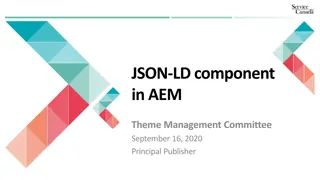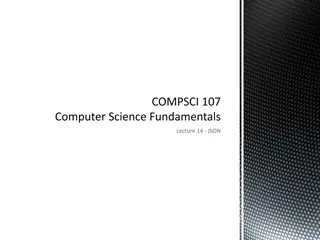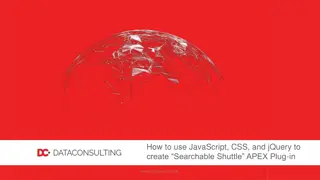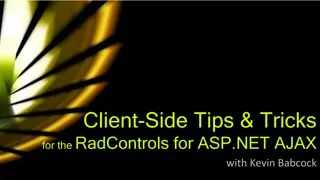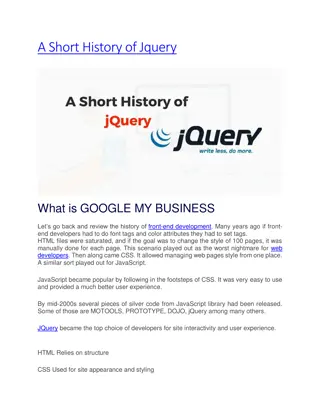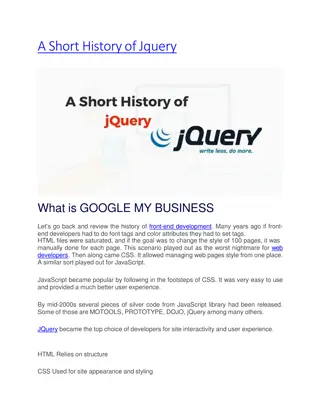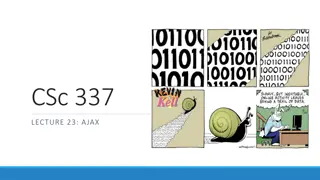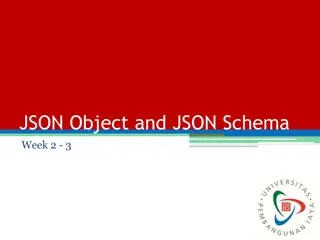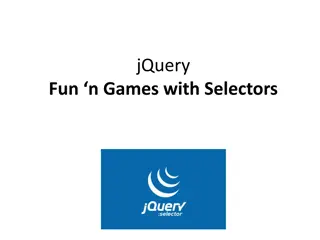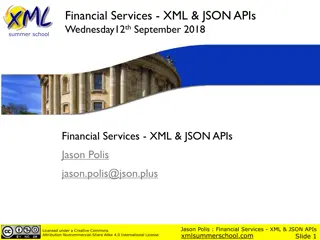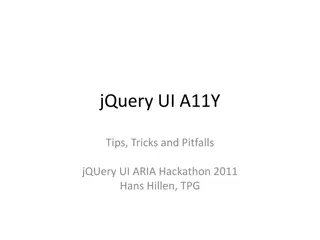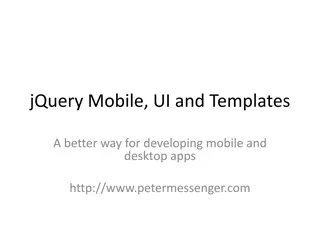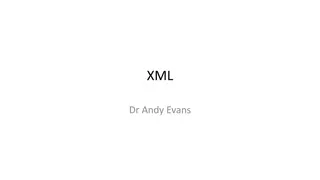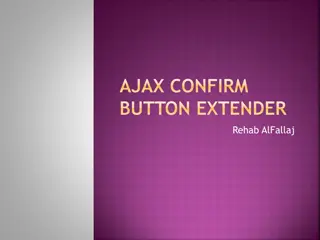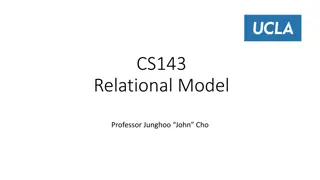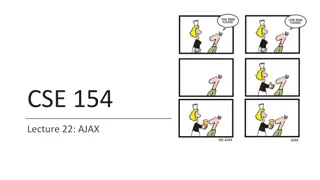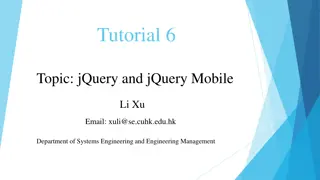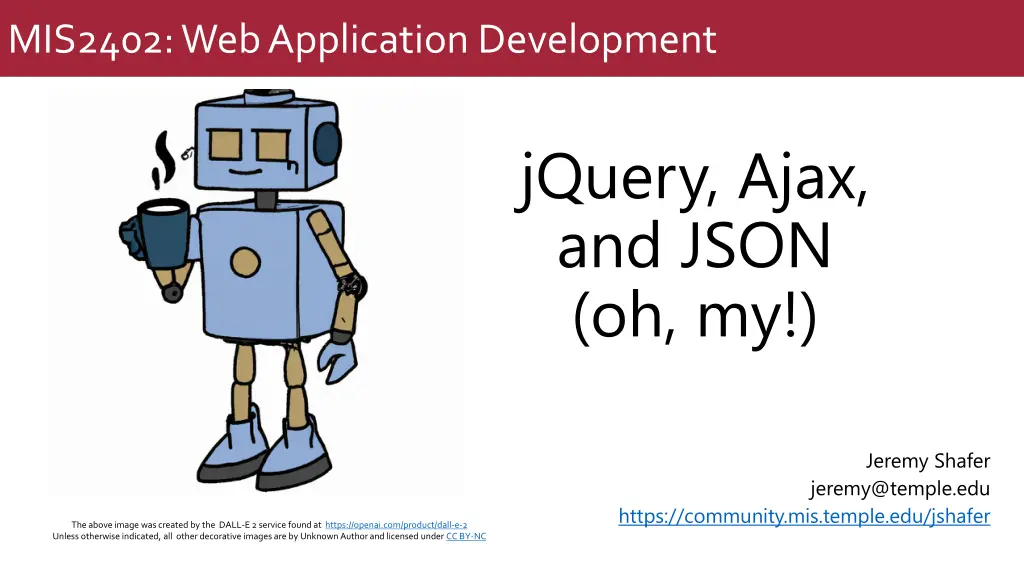
Understanding jQuery, JSON, Ajax in Web Development
Explore the fundamentals of jQuery, JSON, and Ajax in web application development. Learn about JSON data format, making Ajax calls, and utilizing jQuery methods effectively. Enhance your skills in handling 2-dimensional JSON data structures and recognizing various jQuery techniques.
Download Presentation

Please find below an Image/Link to download the presentation.
The content on the website is provided AS IS for your information and personal use only. It may not be sold, licensed, or shared on other websites without obtaining consent from the author. If you encounter any issues during the download, it is possible that the publisher has removed the file from their server.
You are allowed to download the files provided on this website for personal or commercial use, subject to the condition that they are used lawfully. All files are the property of their respective owners.
The content on the website is provided AS IS for your information and personal use only. It may not be sold, licensed, or shared on other websites without obtaining consent from the author.
E N D
Presentation Transcript
MIS2402: Web Application Development jQuery, Ajax, and JSON (oh, my!) Jeremy Shafer jeremy@temple.edu https://community.mis.temple.edu/jshafer The above image was created by the DALL-E 2 service found at https://openai.com/product/dall-e-2 Unless otherwise indicated, all other decorative images are by Unknown Author and licensed under CC BY-NC
Agenda What is jQuery again? What is JSON? What is Ajax? $.getJSON - One technique for making an Ajax call Slide 2
By the end of this class 1. Recognize the syntax of 2-dimensional JSON data. 2. Understand and describe what an Ajax call is. 3. Know which of several possible jQuery methods we will use in this class. Slide 3
Lets remember jQuery jQuery is a library. The jQuery library is a collection of JavaScript functions that are professionally developed and free for use. They are meant to help you do common tasks more simply. We introduced a few jQuery methods early in the semester and we have been quietly using them all semester long. .html() .val() .append() Discuss: What do each of the above do? Slide 4
JSON JSON is a data format. Most of you have already encountered JSON in another course, MIS2502 Data Analytics. JSON is short for JavaScript Object Notation. JSON is the convention for representing arrays and simple objects in JavaScript. [ ] for numerically indexed arrays { } for simple objects (a.k.a. associative arrays, a.k.a key / value pairs ) JSON is an extremely popular data format used to exchange data between systems. It is pronounced Jay - Sawn not Jason Slide 5
What does JSON look like? A JSON object often looks like a collection of key/value pairs as illustrated here: [{ "KEY" : "VALUE", "KEY" : "VALUE", "KEY" : "VALUE" }] There are many acceptable variations on this theme, but this is common! Slide 6
For example: let people = [{ "NameOfInsured" : "Jeremy Shafer", "Spouse" : "Kimberly Shafer", "Dependents" : ["Amanda","Tyler","Jordan"] }, { }, { } ] people[0][ Dependents ][1] DISCUSS: How would you get to the piece of data Tyler ? Slide 7
Ok, so whats Ajax? AJAX is short for Asynchronous JavaScript and XML It is the combination of these technologies, not a separate technology in itself Slide 8
AJAX uses JavaScript to call resources Web server Browser JavaScript Engine Database The format of the data might be JSON, or XML, or CSV, or something else. No matter what the format is, this is still and Ajax request. Slide 10
A little Ajax history Not this Jesse James! The term "Ajax" was publicly stated on 18 February 2005 by Jesse James Garrett in an article titled "Ajax: A New Approach to Web Applications", based on techniques used on Google pages. This object acts like a browser, inside the browser. The object is used to retrieve a web resource. XMLHttpRequest() Slide 11
You can make Ajax calls with nothing but JavaScript Yuck! Slide 12
Or using jQuery There s actually a piece here that we re intentionally leaving out for now. We would use an optional parameter here to send data to someurl Yes, there really is a dot here. $.getJSON(someurl, function(result) { some things to do }) There are other jQuery methods used to do make Ajax calls: .ajax() .get() .load() .post() This piece is called the callback function . A list of jQuery Ajax methods can be found here: https://www.w3schools.com/jquery/jquery _ref_ajax.asp It is the function, that runs, when the call to someurl comes back. Slide 13
One more time This is the callback function that will execute when the Ajax call is a success. $.getJSON(someurl, function(result) { some things to do}); Result is the simple object returned by the getJSON method. The URL to visit One or more commands. I can use the data in result here! 14
Concluding Thoughts CDN (jQuery) Web API Web Server CDN (Bootstrap) CDN (other ?) Web API Slide 15
Lets review What is JSON short for? What is Ajax? What is the purpose of jQuery? Do I need jQuery to make an Ajax call? What is a callback function? Which jQuery method will we use in this class to make Ajax calls? Slide 16
Time for some work Slide 17

